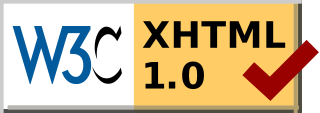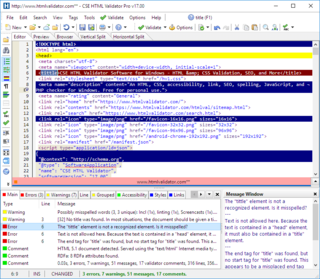A document type definition (DTD) is a specification file that contains set of markup declarations that define a document type for an SGML-family markup language. The DTD specification file can be used to validate documents.

HyperText Markup Language (HTML) is the standard markup language for documents designed to be displayed in a web browser. It defines the content and structure of web content. It is often assisted by technologies such as Cascading Style Sheets (CSS) and scripting languages such as JavaScript.

Extensible Markup Language (XML) is a markup language and file format for storing, transmitting, and reconstructing arbitrary data. It defines a set of rules for encoding documents in a format that is both human-readable and machine-readable. The World Wide Web Consortium's XML 1.0 Specification of 1998 and several other related specifications—all of them free open standards—define XML.

Apache Struts 1 is an open-source web application framework for developing Java EE web applications. It uses and extends the Java Servlet API to encourage developers to adopt a model–view–controller (MVC) architecture. It was originally created by Craig McClanahan and donated to the Apache Foundation in May 2000. Formerly located under the Apache Jakarta Project and known as Jakarta Struts, it became a top-level Apache project in 2005.

The Markup Validation Service is a validator by the World Wide Web Consortium (W3C) that allows Internet users to check pre-HTML5 HTML and XHTML documents for well-formed markup against a document type definition. Markup validation is an important step towards ensuring the technical quality of web pages. However, it is not a complete measure of web standards conformance. Though W3C validation is important for browser compatibility and site usability, it has not been confirmed what effect it has on search engine optimization.
A user interface markup language is a markup language that renders and describes graphical user interfaces and controls. Many of these markup languages are dialects of XML and are dependent upon a pre-existing scripting language engine, usually a JavaScript engine, for rendering of controls and extra scriptability.
Apache Wicket, commonly referred to as Wicket, is a component-based web application framework for the Java programming language conceptually similar to JavaServer Faces and Tapestry. It was originally written by Jonathan Locke in April 2004. Version 1.0 was released in June 2005. It graduated into an Apache top-level project in June 2007.

Apache Tapestry is an open-source component-oriented Java web application framework conceptually similar to JavaServer Faces and Apache Wicket. Tapestry was created by Howard Lewis Ship, and was adopted by the Apache Software Foundation as a top-level project in 2006.

A web template system in web publishing allows web designers and developers to work with web templates to automatically generate custom web pages, such as the results from a search. This reuses static web page elements while defining dynamic elements based on web request parameters. Web templates support static content, providing basic structure and appearance. Developers can implement templates from content management systems, web application frameworks, and HTML editors.
Extensible HyperText Markup Language (XHTML) is part of the family of XML markup languages which mirrors or extends versions of the widely used HyperText Markup Language (HTML), the language in which Web pages are formulated.
In computing, Facelets is an open-source Web template system under the Apache license and the default view handler technology for Jakarta Faces. The language requires valid input XML documents to work. Facelets supports all of the JSF UI components and focuses completely on building the JSF component tree, reflecting the view for a JSF application.
Apache Click is a page and component oriented web application framework for the Java language and is built on top of the Java Servlet API.
Java view technologies and frameworks are web-based software libraries that provide the user interface, or "view-layer", of Java web applications. Such application frameworks are used for defining web pages and handling the HTTP requests (clicks) generated by those web pages. As a sub-category of web frameworks, view-layer frameworks often overlap to varying degrees with web frameworks that provide other functionality for Java web applications.
ZK is an open-source Ajax Web application framework, written in Java, that enables creation of graphical user interfaces for Web applications with little required programming knowledge.

CSS HTML Validator is an HTML editor and CSS editor for Windows that helps web developers create syntactically correct and accessible HTML/HTML5, XHTML, and CSS documents by locating errors, potential problems like browser compatibility issues, and common mistakes. It is also able to check links, check spelling, suggest improvements, alert developers to deprecated, obsolete, or proprietary tags, attributes, and CSS properties, and find issues that can affect search engine optimization.

Spring Roo is an open-source software tool that uses convention-over-configuration principles to provide rapid application development of Java-based enterprise software. The resulting applications use common Java technologies such as Spring Framework, Java Persistence API, Thymeleaf, Apache Maven and AspectJ. Spring Roo is a member of the Spring portfolio of projects.
XHTML+RDFa is an extended version of the XHTML markup language for supporting RDF through a collection of attributes and processing rules in the form of well-formed XML documents. XHTML+RDFa is one of the techniques used to develop Semantic Web content by embedding rich semantic markup. Version 1.1 of the language is a superset of XHTML 1.1, integrating the attributes according to RDFa Core 1.1. In other words, it is an RDFa support through XHTML Modularization.
JWt is an open-source widget-centric web application framework for the Java programming language developed by Emweb. It has an API that uses established GUI application development patterns. The programming model is component-based and event-driven, similar to Swing.
A document type declaration, or DOCTYPE, is an instruction that associates a particular XML or SGML document with a document type definition (DTD). In the serialized form of the document, it manifests as a short string of markup that conforms to a particular syntax.







